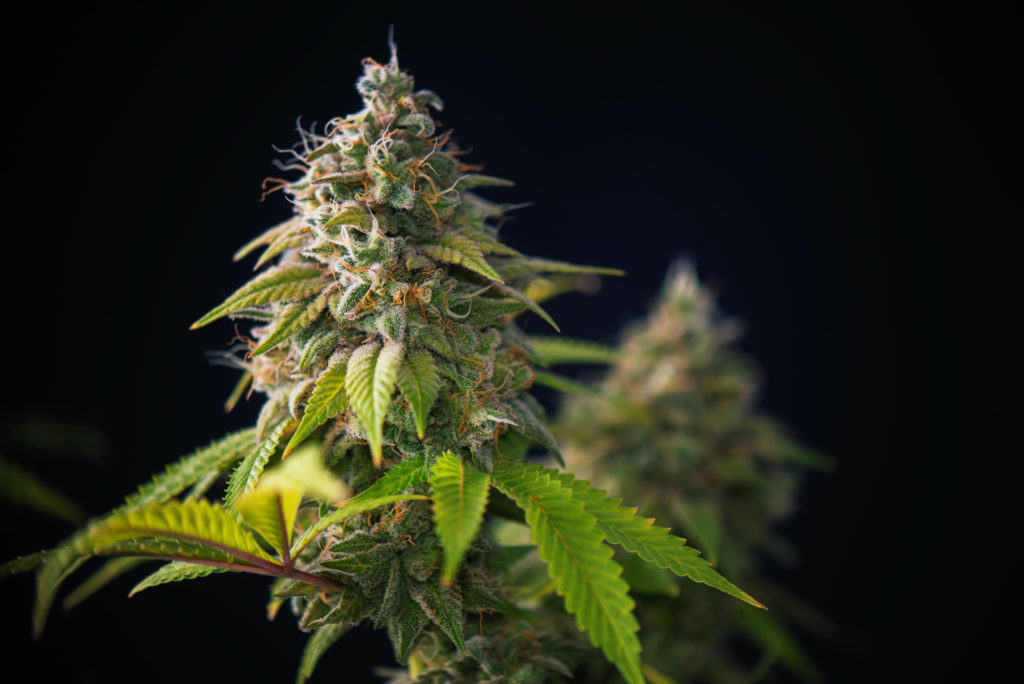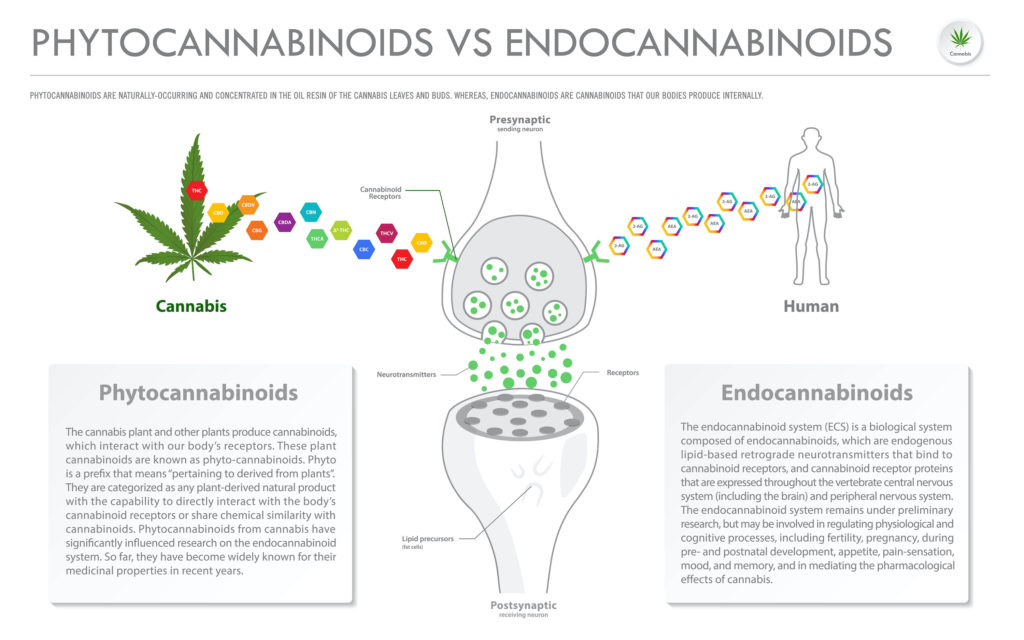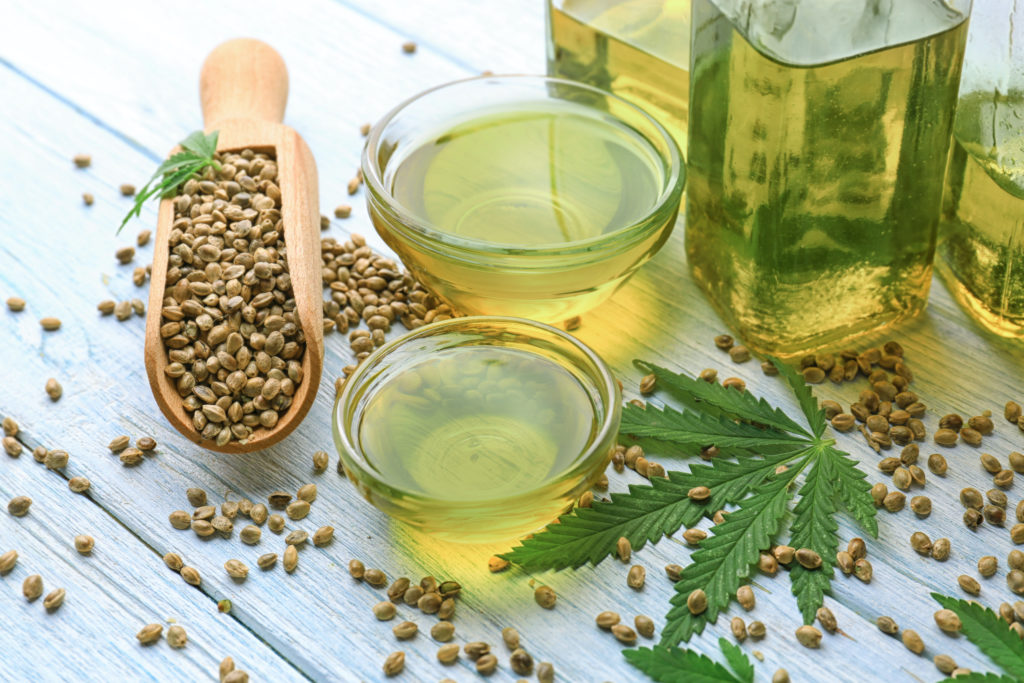
The tale of two cannabinoids is told by endocannabinoids and phytocannabinoids. Endocannabinoids are naturally produced by your body, regardless of your cannabis use. Meanwhile, phytocannabinoids are produced by plants.
Although both fall into the general classification of cannabinoids, phytocannabinoids are often referred to as just “cannabinoids” in the popular media.
Nevertheless, all cannabinoids — whether they’re produced by your body or by the cannabis plants — have important implications for your physical well being.
Differentiating Between the Different Types of Cannabinoids

Cannabinoid is a broad term for compounds produced by plants and mammals alike. These compounds help regulate a variety of biological functions.
Phytocannabinoids are produced by plants, whereas endocannabinoids are produced endogenously (naturally and internally) by mammals.
Additionally, our bodies can’t break down phytocannabinoids. Instead, they undergo biotransformation in the liver after being consumed or inhaled. Through hydroxylation and oxidation in the liver, phytocannabinoids are converted into glucuronide. Glucuronide is a water-soluble compound that is easily excreted by the body.
Evolutionarily, researchers have contemplated which came first: endocannabinoids or phytocannabinoids? While it’s natural to assume phytocannabinoids appeared before endocannabinoids, that doesn’t seem to be the case.
Instead, it’s believed that endocannabinoids came first because mature black truffles (Tuber melanosporum Vittad.) contain the endocannabinoid anandamide. Black truffles evolved during the Jurassic period 140 to 180 million years ago.
Many mammals that have endocannabinoid systems today descended from ancestors who were involved in black truffle spore dispersal.
The plant genus Cannabis, on the other hand, evolved roughly 28 million years ago. Thus, phytocannabinoids appeared in nature after endocannabinoids.
Which Cannabinoids Are Produced by the Body?
The two main endocannabinoids in your body are N-arachidonoylethanolamine (a.k.a. anandamide or AEA) and 2-arachidonoylglycerol (2-AG).
Anandamide is considered the “bliss molecule,” as it’s associated with feelings of wellbeing. The release of anandamide is also associated with the “runner’s high” many describe after an intense jog.
2-AG is implicated in a variety of bodily processes, including immune cell activation and inflammation regulation. Inflammation is your body’s first response to injury and illness — it begins the healing process. But inflammation, when out of control, can have serious, adverse health consequences.
The endocannabinoid 2-AG provides balance to your body’s inflammatory response by decreasing pro-inflammatory cytokines and increasing anti-inflammatory cytokines as your body finishes healing.
Cytokines are small proteins that play an important role in cell signaling. Thus, 2-AG decreases the cytokines that release inflammatory signals and increases the cytokines with anti-inflammatory signals.
Endocannabinoids & Homeostasis
Whereas phytocannabinoids are responsible for more medicinal effects on the body, endocannabinoids are more involved in maintaining homeostasis.
Homeostasis describes a stable internal body environment, and it’s contingent upon a constant balance of nutrients, oxygen, water, body temperature, and blood pressure. This balance is maintained by negative and positive feedback mechanisms in the body.
The immune cell activation and inflammatory regulation of endocannabinoids are part of their homeostatic mechanisms. The endocannabinoid system also plays a role in maintaining gut homeostasis by regulating gastrointestinal movements and inflammation.
Read more: How Cannabis Affects Your Gut Bacteria
What Are Phytocannabinoids?
Phytocannabinoids are produced by plants — namely, Cannabis. Though, phytocannabinoids have been detected in other flowering plants and fungi, as well.
Liverworts (Marchantiophyta), wolly umbrella (Helichrysum umbraculigerum), and licorice roots (Glycyrrhiza foetida Desf.) are examples of flowering plants that also produce phytocannabinoids. Fungi in the Albatrellus genus produce phytocannabinoids, too.
Key Takeaway: Endocannabinoids vs. Phytocannabinoids

Endocannabinoids are produced endogenously by your body, whereas phytocannabinoids are produced by plants. Endocannabinoids display more homeostatic effects on the body, whereas phytocannabinoids have more medicinal effects.
The most important key takeaways are:
- Evolutionarily, endocannabinoids likely appeared in nature before phytocannabinoids.
- Anandamide and 2-AG are the primary endocannabinoids in your body.
- Anandamide is associated with feelings of wellbeing.
- 2-AG regulates immune cell activation and inflammatory processes.
- Phytocannabinoids aren’t exclusive to Cannabis plants — they’re also found in liverworts, wolly umbrellas, licorice roots, and certain fungi.
- Many of the major phytocannabinoids found in cannabis have anti-inflammatory, antibacterial, anxiety-relieving, sedating, or exciting properties. Some phytocannabinoids also affect appetite and mood.
Want to learn more about the science behind cannabis? Listen to S3E1 of the Cannabis Science Today podcast, “Cannabis Alchemy with Dr. Donald Land.”